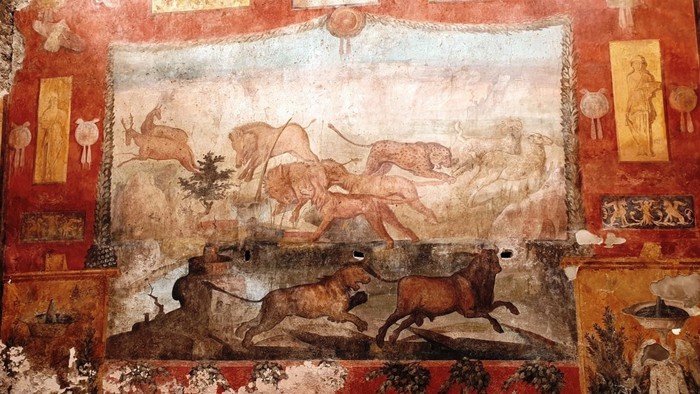POMPEII - In Pompeii, the large fresco in the garden of the Casa dei Ceii returns to shine in its intense colors at the end of the restoration on the decorative elements.
Like a film faded by time and restored, so it comes back to life, in all its splendor and vividness, underlines the Archaeological Park of Pompeii, the large painting that adorns the back wall of the garden of this house, with the hunting scene with animals wild, "together with the scenes of Egyptian landscapes populated by Pygmies and animals from the Nile Delta depicted on the side walls".
These were often recurring subjects in the decoration of the perimeter walls of the Pompeian gardens, in order to illusionistically enlarge the dimensions of these spaces and evoke an idyllic and suggestive atmosphere within them.
In this case, in all likelihood, the theme of the paintings also testified to a link and a specific interest that the owner of the domus had for the Egyptian world and for the cult of Isis, particularly widespread in Pompeii in the last years of the city's life.
Over the years, due to the lack of adequate maintenance and the use of unsuitable restoration practices, there has been a progressive deterioration of the paintings and damage to the frescoes, especially in the lower parts where humidity is most affected.
Thanks to a very complex intervention, it was possible to clean the pictorial film also by using the laser, which made it possible to clean up important portions of the painting, especially in the part relating to the botanical decoration of the fresco.
The erased parts of the painting were recovered through a precise pictorial retouching.
The whole environment has been closed to prevent rainwater infiltration in the future and to preserve the area.
The intervention was carried out with ordinary funds from the Archaeological Park of Pompeii.
The Casa dei Ceii, excavated between 1913 and 1914, represents one of the rare examples of an ancient dwelling of the late Samnite period (II century BC).
The ownership of the domus has been attributed to the magistrate Lucius Ceius Secundus, on the basis of an electoral inscription painted on the external facade of the house.
The facade of the domus, with its white stucco paneling and the high portal crowned by cubic capitals, is an example of the severe appearance that a mid-level house of the late Samnite period (II century BC) must have had.
At the center of the peculiar tetrastyle atrium is the basin of the impluvium, made with fragments of cut amphorae, according to a technique widespread in Greece but that Pompeii finds only another comparison in the house of the Ancient Hunt.
In the past years the domus had been the subject of redevelopment interventions, rainwater regulation and maintenance of the roofs, as part of the Great Pompeii project, made necessary due to a progressive loss of functionality of the same, which over the years was exposing to a serious risk of deterioration in the rooms below, characterized by decorated plasters and floors of great value.
(HANDLE).

